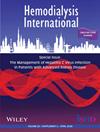Long-term efficacy and risk factors of balloon-assisted maturation for radial-cephalic arteriovenous fistula with small-caliber veins
Abstract
Introduction
Balloon angioplasty maturation (BAM) is a salvage method for autologous arteriovenous fistula (AVF) maturation failure. AVF creation using small-diameter veins is considered to have poor outcomes. Therefore, this study aimed to explore the long-term patency of small-diameter veins (≤3 mm) using BAM.
Methods
BAM was performed if the fistula failed to mature and function adequately to provide prescribed dialysis.
Findings
Out of 61 AVFs, 22 AVFs successfully matured without further intervention (AVF group) and 39 AVFs failed to mature. Except for 1 patient who required peritoneal dialysis, the remaining 38 patients received salvage BAM, and 36 of those successful matured (BAM group). Kaplan–Meier analysis revealed no significant differences between the AVF and BAM groups in terms of primary functional patency (p = 0.503) and assisted functional patency (p = 0.499). Compared with the AVF group, the BAM group had similar assisted primary functional patency (1-year: 94.7% vs. 93.1%; 3-year: 88.0% vs. 93.1%; 5-year: 79.2% vs. 88.3%). In addition, there were no significant difference between groups in the duration of primary functional patency and assisted primary functional patency (p > 0.05). Multivariate analyses showed that vein diameter and number of BAM procedures were independent predictors of primary functional patency in the AVF group and BAM group, respectively. Patient with 1 mm increase in vein size had 0.13-fold probability of having decreased duration of patency (HR = 0.13, 95% CI: 0.02–0.99, p = 0.049), while patients who received two times of BAM procedures were 2.885 as likely to have decreased duration of primary functional patency (HR = 2.885, 95% CI: 1.09–7.63, p = 0.033) than patients who received one BAM procedure.
Discussion
BAM is a relatively effective salvage management option with an acceptable long-term patency rate, even for small cephalic veins.

 求助内容:
求助内容: 应助结果提醒方式:
应助结果提醒方式:


